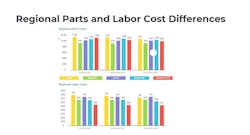Significant fleet maintenance costs seemed to stabilize in 2023, according to two recent market reports. While parts costs were relatively stable throughout the year, technician labor costs continued to increase significantly.
The American Trucking Associations’ Technology & Maintenance Council released two reports on maintenance costs fleets faced in 2023: the VMRS System Service Data Quarterly Report with Decisiv, and the annual State of Heavy-Duty Repair Report with Fullbay.
Maintenance material costs stabilized. The counter sales of heavy-duty shops increased significantly year over year, but parts costs decreased slightly. Both reports found that labor costs increased in 2023.
“We have to reconcile what we saw with hyperinflation,” Fullbay COO Chris O’Brien told FleetOwner. “Unless there’s some sort of major disruption to the supply chain, I would predict that it will continue to stabilize.”
See also: How fleets can combat rising maintenance costs
Decisiv: Parts costs dropped year over year, while labor rose
Combined parts and labor expenses fell 1.4% during the fourth quarter of 2023 but were still up compared to Q4 2022, according to a report from TMC and Decisiv.
As reported in the latest Decisiv/TMC North American Service Event Benchmark Report, expenses from 25 key vehicle maintenance reporting standards systems had dropped in Q4, reversing a 2.1% increase from Q3.
“We are still facing an industry-wide challenge to find technicians, which is increasing labor costs for fleets and service providers,” Dick Hyatt, Decisiv president and CEO, said. “However, quarter and annual parts cost decreases, driven by a reduction in pricing pressures and the influx of more new trucks, is bringing some welcome relief.”
The Decisiv/TMC report found that, year over year, combined parts and labor costs were still 0.2% higher than in Q4 2022. Parts prices dropped 2.2%, while labor costs rose 4.0%.
“It has been a moderating year,” Robert Ziemba, senior director of marketing for Decisiv, told FleetOwner. “The first quarter, we were up less than a percent; second quarter, we were down just over a percent; third quarter, we were up almost 2%; but then this last quarter, we were down 1.4%.”
According to Decisiv combined parts and labor costs went up 8% across all of 2022. By comparison, across 2023, cost changes totaled near zero.
Overall, Q4’s parts and labor costs trended down, thanks to supply chain improvements and new trucks entering the market. According to John Hitch in FleetMaintenance, maintenance costs for tires, steering, and cooling systems dropped roughly 12%. Meanwhile, costs for power takeoff, cab and sheet metal, and wheels, rims, hubs, and bearings increased about 15%.
“If you look at year-over-year parts costs, they’re down over 2%,” Ziemba said. “That’s mostly due to supply chain issues being resolved. We also saw a decline in the freight tonnage, which results in less miles being driven so there’s not as much maintenance required. The freight tonnage index that the ATA does said that it dropped about 1.7%. That gives you an indication that trucks aren’t being driven as much, so the parts demand is not as high.”
The rise in labor costs “has a lot to do with the demand for diesel technicians,” Ziemba said.
See also: Tips on tools to combat rising trucking costs
There are not enough trained personnel to satisfy the demand for new diesel technicians in the workforce. TechForce Foundation’s 2023 Technician Supply & Demand Report shows 3.1 open positions for every postsecondary technical program graduate in the diesel sector. This difference between technician supply and demand translated to higher labor costs in 2023.
Fullbay: Counter sales, labor rates are up year-over-year
The fourth annual State of Heavy-Duty Repair Report found that both counter sales and labor rates increased significantly in 2023 over 2022.
Nearly half of the report’s survey respondents reported a 21%-40% increase in counter sales from 2022 to 2023. Labor rates across the U.S. rose 9% in 2023, roughly equivalent to a $10 per hour increase.
See also: How carriers can best manage insurance costs and risks in 2024
Shops’ rise in counter sales is partly thanks to improvements to pandemic-era supply chain disruptions, according to Fullbay COO Chris O’Brien. During the pandemic, shops were less able to rely on local distributors’ final mile delivery to supply single parts as needed.





